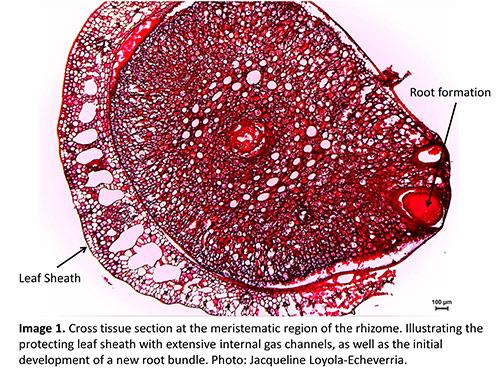
Seagrasses use internal gas chambers, Aerenchyma, to transport oxygen from leaves to roots and thus protect themselves from toxins like hydrogen sulphide.
A new experimental approach to seagrass research by C3 scientists confirms that seagrasses have chemical defence mechanisms to protect vital plant structures from suffocation. The results of the research, published in the leading plant science journal New Phytologist, show that by actively modifying chemical conditions in the surrounding sediments these plants accommodate their own growth and protect themselves from toxins.
Seagrass meadows are extremely important marine ecosystems, enhancing marine biodiversity, protecting coastal environments and locking up carbon in sediments. The alarming worldwide decline of seagrasses means that marine ecologists need insights into the mechanisms behind seagrass die-back in order to help preserve and protect them.
“We wanted to explore whether seagrasses are able to modify their below-ground chemical microenvironment through the release of chemical compounds from their root tissue and if the release of these chemicals is affected by low oxygen conditions in the water column at night, when photosynthesis shuts down,” C3 PhD student, and lead author, Mr Kasper Elgetti Brodersen, says.

Split flow chamber showing below ground tissue of Z. muelleri embedded in artificial transparent sediment.
Image: K Elgetti Brodersen
Brodersen explained that seagrasses have extensive internal gas channels that very efficiently transport oxygen from the seagrass leaves to the roots. This allows the seagrass to fight off toxins, such as hydrogen sulphide, produced by bacteria in the oxygen depleted sediments surrounding the roots. Measuring the biogeochemical reactions taking place in the root microenvironment requires the use of fragile and sensitive microsensors.
“Current techniques have their limitations. It became apparent that first we needed to design a new experimental setup that enabled better fine scale observation of the root microenvironment,” Brodersen says.
The team developed a new flow chamber, described recently in the journal Marine Biology, so they could both visually assess the below ground tissue surface of the seagrass roots, while handling the tiny microsensors and modifying the above-ground environmental conditions independently. To mimic the seagrass root chemical microenvironment, the chamber can be filled with an oxygen free sulphidic medium that acts as an artificial sediment.
“Our new experimental approach simplifies the use of microsensors for measurements of the chemical microenvironment in the root microenvironment of segrasses and has broad application to all microscale studies of all rooted aquatic plants,” Brodersen says.
Having perfected their technique, the novel experimental chamber was used in conjunction with electrochemical microsensors to reveal how seagrasses modify the geochemical conditions in the immediate vicinity of the roots via oxygen release. This has the effect of detoxifying the surrounding sediment by ‘scavenging’ phytotoxic hydrogen sulphide.
“From a management perspective, this research tells us that the oxygen status of the water column around seagrass should be as high as possible to support and thereby maintain the chemical defence mechanism of the seagrass, otherwise it becomes ineffective,” Brodersen says.
“Algal blooms, elevated seawater temperatures, dredging operations and nutrient loading from runoff all deplete water column oxygen levels thus impacting on the natural defence mechanisms of seagrasses. To prevent severe seagrass die-off events in the future, these stressors should be controlled as much as possible to support the natural defence mechanisms of segrasses”, Brodersen says.
Publication details:
Kasper Elgetti Brodersen, Daniel Aagren Nielsen, Peter J Ralph and Michael Kühl (2014). A split flow chamber with artificial sediment to examine the below-ground microenvironment of aquatic macrophytes. Marine Biology DOI 10.1007/s00227-014-2542-3
Kasper Elgetti Brodersen, Daniel Aagren Nielsen, Peter J Ralph and Michael Kühl (2014). Oxic microshield and local pH enhancement protects Zostera muelleri from sediment derived hydrogen sulphide. New Phytologist DOI: 10.1111/nph.13124

